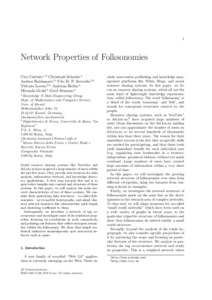Datum
2007Autor
Cattuto, CiroSchmitz, ChristophBaldassarri, AndreaServedio, Vito D. P.Loreto, VittorioHotho, AndreasGrahl, MirandaStumme, GerdMetadata
Zur Langanzeige
Preprint

Network properties of folksonomies
Zusammenfassung
Social resource sharing systems like YouTube and del.icio.us have acquired a large number of users within the last few years. They provide rich resources for data analysis, information retrieval, and knowledge discovery applications. A first step towards this end is to gain better insights into content and structure of these systems. In this paper, we will analyse the main network characteristics of two of these systems. We consider their underlying data structures â so-called folksonomies â as tri-partite hypergraphs, and adapt classical network measures like characteristic path length and clustering coefficient to them. Subsequently, we introduce a network of tag cooccurrence and investigate some of its statistical properties, focusing on correlations in node connectivity and pointing out features that reflect emergent semantics within the folksonomy. We show that simple statistical indicators unambiguously spot non-social behavior such as spam.
Zitieren
@article{urn:nbn:de:hebis:34-2009042027044,
author={Cattuto, Ciro and Schmitz, Christoph and Baldassarri, Andrea and Servedio, Vito D. P. and Loreto, Vittorio and Hotho, Andreas and Grahl, Miranda and Stumme, Gerd},
title={Network properties of folksonomies},
year={2007}
}
0500 Oax
0501 Text $btxt$2rdacontent
0502 Computermedien $bc$2rdacarrier
1100 2007$n2007
1500 1/eng
2050 ##0##urn:nbn:de:hebis:34-2009042027044
3000 Cattuto, Ciro
3010 Schmitz, Christoph
3010 Baldassarri, Andrea
3010 Servedio, Vito D. P.
3010 Loreto, Vittorio
3010 Hotho, Andreas
3010 Grahl, Miranda
3010 Stumme, Gerd
4000 Network properties of folksonomies / Cattuto, Ciro
4030
4060 Online-Ressource
4085 ##0##=u http://nbn-resolving.de/urn:nbn:de:hebis:34-2009042027044=x R
4204 \$dPreprint
4170
5550 {{Wissenserwerb}}
5550 {{Wissensmanagement}}
7136 ##0##urn:nbn:de:hebis:34-2009042027044
<resource xsi:schemaLocation="http://datacite.org/schema/kernel-2.2 http://schema.datacite.org/meta/kernel-2.2/metadata.xsd"> 2009-04-20T10:09:03Z 2009-04-20T10:09:03Z 2007 urn:nbn:de:hebis:34-2009042027044 http://hdl.handle.net/123456789/2009042027044 5770237 bytes application/pdf eng Urheberrechtlich geschützt https://rightsstatements.org/page/InC/1.0/ 004 Network properties of folksonomies Preprint Social resource sharing systems like YouTube and del.icio.us have acquired a large number of users within the last few years. They provide rich resources for data analysis, information retrieval, and knowledge discovery applications. A first step towards this end is to gain better insights into content and structure of these systems. In this paper, we will analyse the main network characteristics of two of these systems. We consider their underlying data structures â so-called folksonomies â as tri-partite hypergraphs, and adapt classical network measures like characteristic path length and clustering coefficient to them. Subsequently, we introduce a network of tag cooccurrence and investigate some of its statistical properties, focusing on correlations in node connectivity and pointing out features that reflect emergent semantics within the folksonomy. We show that simple statistical indicators unambiguously spot non-social behavior such as spam. open access Cattuto, Ciro Schmitz, Christoph Baldassarri, Andrea Servedio, Vito D. P. Loreto, Vittorio Hotho, Andreas Grahl, Miranda Stumme, Gerd Auch erschienen in: AI Communications. Amsterdam : IOP Press, 2007, Vol. 20, 4, S. 245-262. ISSN 0921-7126 Wissenserwerb Wissensmanagement </resource>
Die folgenden Lizenzbestimmungen sind mit dieser Ressource verbunden:
Urheberrechtlich geschützt

